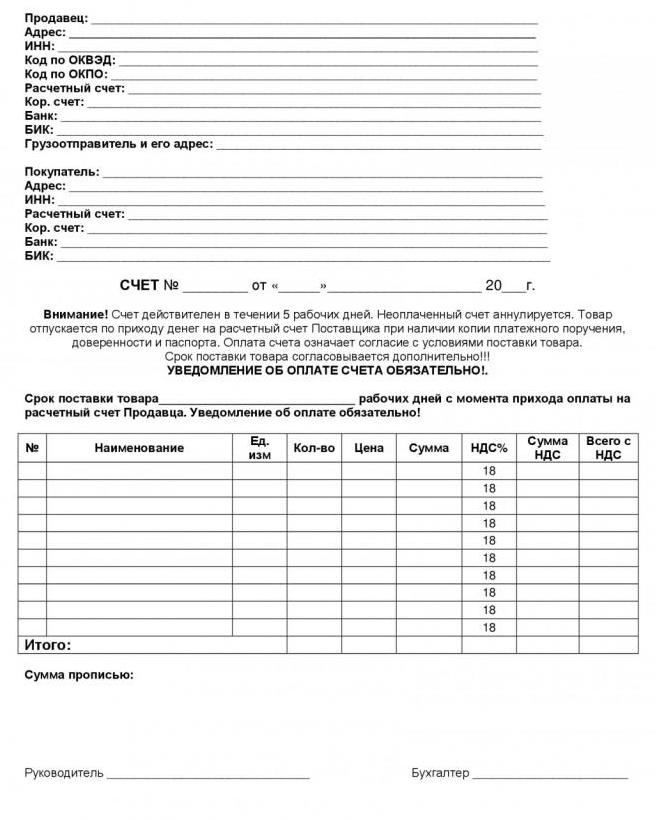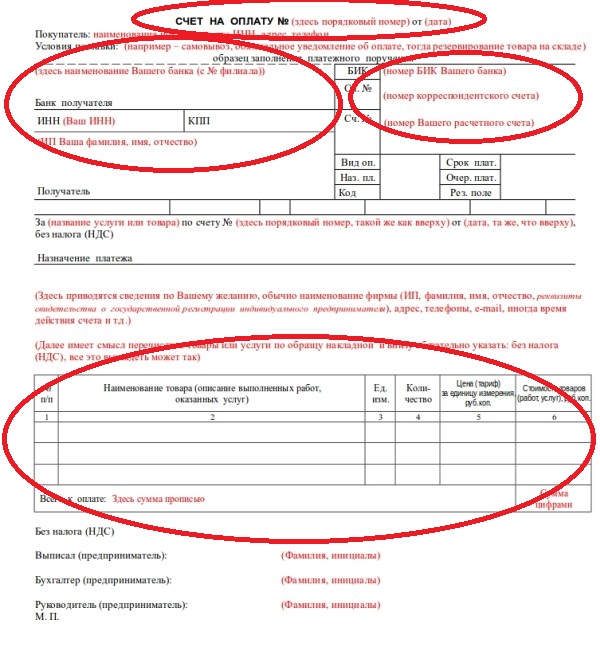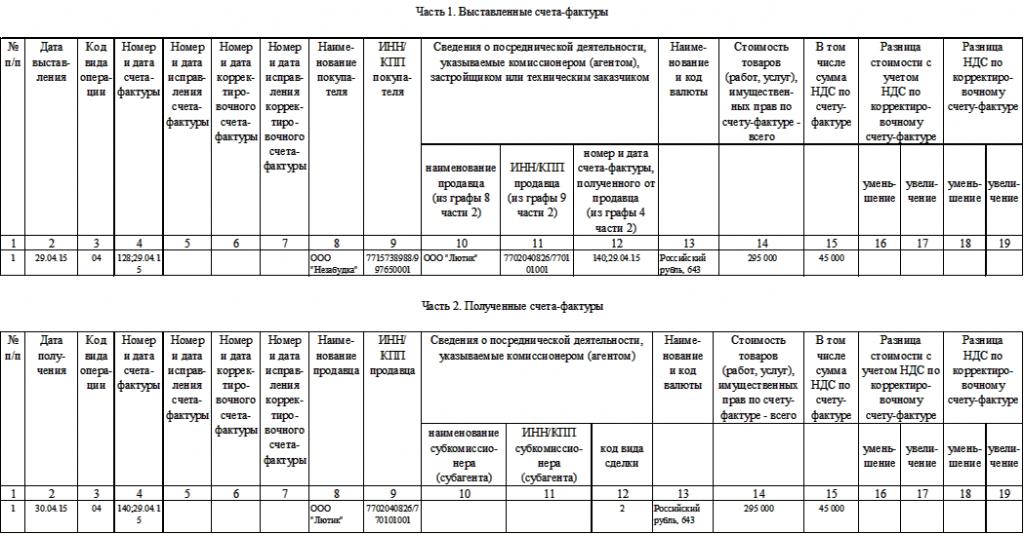Sooner or later, in the activities of an individual entrepreneur, there comes a time when you need to bill your business partner. There is no officially approved form of such a document, therefore, each enterprise or individual entrepreneur independently determines it. At the same time, the account is the basis for settlements, therefore, it must have certain details.
What is an account and its mandatory details
An account is a document that displays the main points of an upcoming transaction. The main purpose of its formation is the requirement to pay for certain services or the supply of goods.
How to invoice? First of all, this is a payment document, so it must contain bank details for payment. In addition, the following information should be present in the invoice:
- full details of the individual entrepreneur, namely F. I. O. and TIN;
- name of organization that will pay the bill, its tax code;
- if the invoice is issued according to the terms of the signed agreement, then the document shall contain a reference to it;
- address of the entrepreneur's location;
- full account details (number and date) so that it can be identified from other requirements;
- the name of the product or service with the maximum description of the products sold;
- quantity of delivered goods;
- unit cost and total amount.
At the end of the document you must indicate the full amount payable. If the entrepreneur is on DOS, then indicate the amount with VAT in numbers and words. At the very end, the IP signature is affixed, if there is an accountant, then his signature and seal (if any).
As additional conditions, the bill may indicate:
- delivery conditions;
- the term for the shipment of goods or the provision of services;
- discounts;
- obligations of the parties;
- penalties.

Whether or not to invoice
Do I need to invoice for payment? In fact, such a procedure is not regulated by law. The parties may act on the basis of the contract, as well as make payments under it. However, the account, nevertheless, allows one to make settlements between counterparties more accurate.
It will be obligatory to issue an invoice, if this is provided for by the conditions of the agreement signed by both parties. Also, such a document will be required if, under the terms of the contract, a clear amount for payment is not prescribed. For example, the delivery of goods is carried out in stages, by additional applications or we are talking about utility bills.
Also, according to the requirements of certain articles of the Tax Code, it is mandatory to invoice in the following cases:
- if the individual entrepreneur is exempt from VAT (Article 145);
- if the document is drawn up personally from the seller, and it is on the general taxation system (Article 145);
- in cases where a partial prepayment has already been received (Article 168).
In any case, the account allows you to quickly draw up financial relations between the parties and make quick payments.

Order of registration
How to issue an invoice and how does it appear? You can make an invoice yourself on sheet A4 or A5, in any office program, for example, in Word or Excel. Today there are many templates, that is, you do not need to reinvent the wheel. If desired, the invoice can be issued on letterhead.
There are also several CRM programs that allow you to create an account on a free basis.It should also be remembered that in spite of the fact that the form of such a document as an account is absent in regulatory documents, but it can be presented at the court hearing as evidence.

Methods of transferring an account to a counterparty
Documents that are generated at enterprises can be transferred in different ways. The account is no exception. It is transmitted like this:
- by fax;
- by email
- by mail
- personally in hands.

The main mistakes in the preparation
How to invoice? This question often arises among beginner individual entrepreneurs. Knowing the mistakes that should not be made, it will be much easier to draw up the correct document.
First of all, if the account is signed by the individual entrepreneur and accountant, then their signatures must be decrypted. If the invoice is sent in the form of an electronic document with the signature of an electronic digital signature, then decryption is no longer required.
It often happens that in the invoice the date of issuing and compiling the document does not coincide. It is not right. And one more problem - inattention when filling in the details for payment. Naturally, if the document is prepared in a special accounting program, this does not happen. But if the IP rarely bills, then before sending it to the counterparty, it is necessary to check the settlement accounts and other details several times.

Billing Journal
A logical question arises - if the form of the account is not regulated by law, then do you need a journal to record them? In fact, such a journal should be compulsory by persons who engage in intermediary services. The form of such an accounting document is provided for by Decree of the Government of the Russian Federation No. 1137.
In this case, the holder of the journal of billed invoices is obliged to enter data on the receipt of bills into it. Regulatory acts provide for the possibility of maintaining such a journal both in electronic and in paper form, although its submission to the Federal Tax Service Inspectorate is provided exclusively in electronic form. The magazine consists of two parts and is maintained quarterly.
In the first part of the journal of received and issued invoices, the invoices received are indicated, and in the second, respectively, - issued. The document is to be submitted to the IFTS on a quarterly basis, that is, for the first quarter until April 20, for the second - until June 20, and so on.
All individual entrepreneurs and legal entities engaged in mediation are required to keep such journals for 4 full years, which are counted from the moment the last entry was entered in it.
For the absence of such a magazine, a fine of 10 thousand rubles is provided, which is the same for both legal entities and individual entrepreneurs.
In other cases, accounting of invoices is carried out exclusively at the request of the businessman.

How to display VAT in the account?
If an individual entrepreneur works on a common basis and is a payer of value added tax, then when invoicing, this tax he must separate in a separate line. In practice, there are two options, and they are both correct.
The total amount payable is calculated including VAT, for example:
“The total amount is: 100,000.00 rubles, including 18% VAT - 18,000.00 thousand rubles. Total to be paid: 100,000.00 rubles. "
The second option:
“The total amount is: 82,000.00 rubles, including 18% VAT - 18,000.00 thousand rubles. Total to be paid: 100,000.00 rubles. " That is, first the amount without VAT is prescribed, then the amount of tax and the total amount payable are allocated.

Due date
How to invoice and correctly display the due date? The deadline by which payment must be made can be indicated both in the document itself and directly in the contract. If the price and the due date are fixed in the contract, then the party that sets it is not entitled to change the value.
If the invoice does not have a deadline in which payment must be made, then this is not a violation. Although in practice, certain difficulties may arise with the “knocking out” of payment.In such cases, most often the terms are prescribed in the contract. If there is no agreement, then the party that must make the payment has a chance to independently determine when it will pay.
The time of payment can also be determined in a certain way. For example, the date of receipt of the invoice or receipt of goods. In any case, the party invoicing for payment and determining the terms of settlements in it guarantees the other party that the cost of the goods or services will not be increased during this period.
In fact, no problems with invoicing IP to LLC should arise. A potential customer contacts the individual entrepreneur, announces his desire to purchase a specific product and its quantity. The seller, on the basis of a written or oral application, forms invoices and transfers them for payment to the counterparty. The party that received the invoice and agreed to pay it transfers the funds to the supplier’s bank account and receives its goods.
